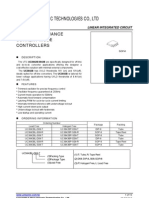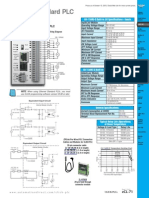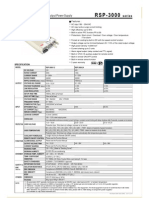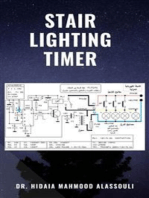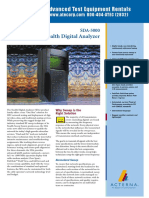A1230 Datasheet
A1230 Datasheet
Uploaded by
Bruno Koch SchmittCopyright:
Available Formats
A1230 Datasheet
A1230 Datasheet
Uploaded by
Bruno Koch SchmittOriginal Title
Copyright
Available Formats
Share this document
Did you find this document useful?
Is this content inappropriate?
Copyright:
Available Formats
A1230 Datasheet
A1230 Datasheet
Uploaded by
Bruno Koch SchmittCopyright:
Available Formats
A1230
Ultra-Sensitive Dual-Channel Quadrature
Hall-Effect Bipolar Switch
FEATURES AND BENEFITS
DESCRIPTION
Two matched Hall-effect switches on a single substrate
1 mm Hall element spacing
Superior temperature stability and industry-leading
jitter performance through use of advanced chopperstabilization topology
Integrated regulator provides 3.3 V operation
Integrated ESD protection from outputs and VCC to
ground
High sensitivity switchpoints
Robust structure for EMC protection
Solid-state reliability
Reverse battery protection on supply and both output
pins
The A1230 is a dual-channel, bipolar switch with two Halleffect sensing elements, each providing a separate digital
output for speed and direction signal processing capability. The
Hall elements are photolithographically aligned to better than
1m. Maintaining accurate mechanical location between the
two active Hall elements eliminates the major manufacturing
hurdle encountered in fine-pitch detection applications. The
A1230 is a highly sensitive, temperature stable magnetic
sensing device ideal for use in ring magnet based, speed and
direction systems located in harsh automotive and industrial
environments.
PACKAGES:
8-Pin SOIC (suffix L)
4-Pin SIP (suffix K)
The A1230 monolithic integrated circuit (IC) contains two
independent Hall-effect bipolar switches located 1 mm apart.
The digital outputs are out of phase so that the outputs are in
quadrature when interfaced with the proper ring magnet design.
This allows easy processing of speed and direction signals.
Extremely low-drift amplifiers guarantee symmetry between
the switches to maintain signal quadrature. The Allegro
patented, high-frequency chopper-stabilization technique
cancels offsets in each channel providing stable operation over
the full specified temperature and voltage ranges.
Additionally, the high-frequency chopping circuits allow
an increased analog signal-to-noise ratio at the input of the
digital comparators internal to the IC. As a result, the A1230
Not to scale
Continued on the next page
VOUTPUTB
VOUTPUTA
2
OUTPUTA
VSupply
1
100
A
A1230
VCC
OUTPUTB
GND
0.1 F
A Resistor is optional
depending on Conducted
Immunity requirements
Typical Application using Regulated Supply
A1230DS, Rev. 4
Ultra-Sensitive Dual-Channel Quadrature
Hall-Effect Bipolar Switch
A1230
Description (continued)
achieves industry-leading digital output jitter performance that is
critical in high performance motor commutation applications. An
on-chip regulator allows the use of this device over a wide operating
voltage range. Post-assembly factory programming at Allegro
provides sensitive switchpoints that are symmetrical between the
two switches.
The A1230 is available in a plastic 8-pin SOIC surface mount
package (L) and a plastic 4-pin SIP (K). Both are available in a
temperature range of 40C to 150C. Each package is lead (Pb)
free, with 100% matte tin plated leadframe.
Selection Guide
Part Number
Packing*
Mounting
A1230LK-T
Bulk, 500 pieces/bag
4-pin SIP through hole
A1230LLTR-T
13-in. reel, 3000 pieces/reel
8-pin SOIC surface mount
Ambient, TA
40C to 150C
*Contact Allegro for additional packing options.
Allegro MicroSystems, LLC
115 Northeast Cutoff, Box 15036
Worcester, Massachusetts 01615-0036 (508) 853-5000
www.allegromicro.com
Ultra-Sensitive Dual-Channel Quadrature
Hall-Effect Bipolar Switch
A1230
SPECIFICATIONS
Absolute Maximum Ratings
Characteristic
Symbol
Supply Voltage
Notes
VCC
Reverse Battery Voltage
Output Off Voltage
Output Sink Current
Magnetic Flux Density
Rating
Units
26.5
VRCC
16
VOUTPUT
VCC
IOUTPUT(Sink)
Internally Limited
Unlimited
Operating Ambient Temperature
TA
40 to 150
Maximum Junction Temperature
TJ(max)
165
Tstg
65 to 170
Storage Temperature
Range L
Pin-Out Diagrams and Terminal List Table
Package K, 4-Pin SIP
Package L, 8-Pin SOIC
Terminal List Table
Pin Number
Name
Function
Package K
Package L
OUTPUTA Output from E1 via first Schmitt circuit
OUTPUTB Output from E2 via second Schmitt circuit
GND
5-8
NC
VCC
Connects power supply to on-chip voltage regulator
Terminal for ground connection
No connection
Allegro MicroSystems, LLC
115 Northeast Cutoff, Box 15036
Worcester, Massachusetts 01615-0036 (508) 853-5000
www.allegromicro.com
Ultra-Sensitive Dual-Channel Quadrature
Hall-Effect Bipolar Switch
A1230
OPERATING CHARACTERISTICS: valid over operating temperature ranges unless otherwise noted; typical data applies to
VCC = 12 V, and TA = 25C
Characteristic
Symbol
Test Conditions
Min.
Typ.
Max.
Unit1
ELECTRICAL CHARACTERISTICS
Supply Voltage2
VCC
Operating; TA 150C
3.3
18
Output Leakage Current
IOUTPUT(OFF)
Either output
<1
10
ICC(OFF)
B < BRP(A) ,B < BRP(B)
3.5
6.0
mA
ICC(ON)
B > BOP(A) ,B > BOP(B)
3.5
6.0
mA
Low Output Voltage
VOUTPUT(ON)
Both outputs; IOUTPUT(SINK) = 20 mA; B > BOP(A), B>
BOP(B)
160
500
mV
Output Sink Current
IOUTPUT(SINK)
20
mA
Output Sink Current, Continuous3
IOUTPUT(SINK)C
TJ < TJ(max) ,VOUTPUT = 12 V
70
mA
Output Sink Current, Peak4
IOUTPUT(SINK)P
t < 3 seconds
220
mA
Chopping Frequency
fC
780
kHz
Output Rise Time
tr
CLOAD = 20 pF, RLOAD = 820
1.8
Output Fall Time
tf
CLOAD = 20 pF, RLOAD = 820
1.2
Power-On Time
tON
B > 40 G or B < 40 G
15
Power-Off Time
tOFF
B > 40 G or B < 40 G
25
Power-On State
POS
B=0G
Low
Supply Current
TRANSIENT PROTECTION CHARACTERISTICS
Supply Zener Voltage
VZ
ICC = 9 mA, TA = 25C
28
Supply Zener Current5
IZ
VS = 28 V
9.0
mA
Reverse-Battery Current
IRCC
VRCC = 18 V, TJ < TJ(max)
15
mA
MAGNETIC CHARACTERISTICS6
Operate Point: B > BOP
BOP(A),BOP(B)
30
Release Point: B < BRP
BRP(A), BRP(B)
30
Hysteresis: BOP(A) BRP(A),
BOP(B) BRP(B)
BHYS(A), BHYS(B)
14
35
Symmetry: Channel A, Channel B,
BOP(A) + BRP(A), BOP(B) + BRP(B)
SYMA, SYMB
35
35
Operate Symmetry: BOP(A) BOP(B)
SYMAB(OP)
25
25
Release Symmetry: BRP(A) BRP(B)
SYMAB(RP)
25
25
11 G (gauss) = 0.1 mT (millitesla).
2When operating at maximum voltage, never exceed maximum junction temperature, T (max). Refer to power derating curve charts.
J
3 Device will survive the current level specified, but operation within magnetic specification cannot be guaranteed.
4 Short circuit of the output to VCC is protected for the time duration specified.
5 Maximum specification limit is equivalent to I
CC(max) + 3 mA.
flux density, B, is indicated as a negative value for north-polarity magnetic fields, and as a positive value for south-polarity magnetic fields. This so-called
algebraic convention supports arithmetic comparison of north and south polarity values, where the relative strength of the field is indicated by the absolute value of B,
and the sign indicates the polarity of the field (for example, a 100G field and a 100 G field have equivalent strength, but opposite polarity).
6 Magnetic
Allegro MicroSystems, LLC
115 Northeast Cutoff, Box 15036
Worcester, Massachusetts 01615-0036 (508) 853-5000
www.allegromicro.com
Ultra-Sensitive Dual-Channel Quadrature
Hall-Effect Bipolar Switch
A1230
EMC
Contact Allegro MicroSystems for EMC performance.
VCC
Programmable
Trim
Regulator
4 Bit
Channel A
Amp
LowPass
Filter
OUTPUTA
Low Noise Signal
Recovery
Hall
Element
E1
Dynamic Offset
Cancellation
2 Bit
Output
Drive
Channel B
Amp
LowPass
Filter
OUTPUTB
Low Noise Signal
Recovery
Hall
Element
E2
Dynamic Offset
Cancellation
2 Bit
Output
Drive
GND
Functional Block Diagram
Allegro MicroSystems, LLC
115 Northeast Cutoff, Box 15036
Worcester, Massachusetts 01615-0036 (508) 853-5000
www.allegromicro.com
Ultra-Sensitive Dual-Channel Quadrature
Hall-Effect Bipolar Switch
A1230
THERMAL CHARACTERISTICS may require derating at maximum conditions, see application information
Characteristic
Symbol
Package Thermal Resistance
Test Conditions*
RJA
Value
Units
Package K, 1-layer PCB with copper limited to solder pads
177
C/W
Package L-8 pin, 1-layer PCB with copper limited to solder pads
140
C/W
Package L-8 pin, 4-layer PCB based on JEDEC standard
80
C/W
*Additional thermal data available on the Allegro Web site.
Maximum Allowable VCC (V)
Power Derating Curve
20
19
18
17
16
15
14
13
12
11
10
9
8
7
6
5
4
3
2
VCC(max)
Package L, 4-layer PCB
(RqJA = 80 C/W)
Package L, 1-layer PCB
(RqJA = 140 C/W)
Package K, 1-layer PCB
(RqJA = 177 C/W)
VCC(min)
20
40
60
80
100
120
140
160
180
Temperature (C)
Power Dissipation, PD (mW)
Power Dissipation versus Ambient Temperature
1900
1800
1700
1600
1500
1400
1300
1200
1100
1000
900
800
700
600
500
400
300
200
100
0
Package L, 4-layer PCB
(RqJA = 80 C/W)
Package L, 1-layer PCB
(RqJA = 140 C/W)
Package K, 1-layer PCB
(RqJA = 177 C/W)
20
40
60
80
100
120
140
160
180
Temperature (C)
Allegro MicroSystems, LLC
115 Northeast Cutoff, Box 15036
Worcester, Massachusetts 01615-0036 (508) 853-5000
www.allegromicro.com
Ultra-Sensitive Dual-Channel Quadrature
Hall-Effect Bipolar Switch
A1230
Electrical Operating Characteristics
ICC(OFF)
ICC(OFF)
8.0
7.0
7.0
Current (mA)
6.0
TA (C)
5.0
-40
4.0
25
3.0
150
2.0
Current (mA)
8.0
VCC (V)
5.0
3.3
4.0
12
3.0
18
2.0
1.0
1.0
0.0
0
10
15
0.0
20
-50
50
100
VCC (V)
Temperature ( C)
ICC(ON)
ICC(ON)
8.0
8.0
7.0
7.0
TA (C)
5.0
-40
4.0
25
3.0
150
2.0
150
200
6.0
Current (mA)
6.0
1.0
VCC (V)
5.0
3.3
4.0
12
3.0
18
2.0
1.0
0.0
0.0
0
10
15
20
-50
VCC (V)
50
100
150
200
Temperature ( C)
VOUTPUT(ON)
500
Voltage (mV)
Current (mA)
6.0
450
VCC (V)
400
Ch. A
350
3.3
300
12
250
18
Ch. B
200
150
3.3
100
12
50
18
0
-50
50
100
150
200
Temperature ( C)
Allegro MicroSystems, LLC
115 Northeast Cutoff, Box 15036
Worcester, Massachusetts 01615-0036 (508) 853-5000
www.allegromicro.com
Ultra-Sensitive Dual-Channel Quadrature
Hall-Effect Bipolar Switch
A1230
Magnetic Operating Characteristics
Channel A, BOP and BRP
Channel A, BOP and BRP
30.0
10.0
25
150
BRP
- 40
0.0
-10.0
25
150
-20.0
Switchpoint (G)
BOP
- 40
20.0
Switchpoint (G)
30.0
TA (C)
-30.0
20.0
VCC (V)
10.0
3.3
BOP
18
0.0
BRP
-10.0
18
-20.0
-30.0
10
15
20
-50
VCC (V)
Channel B, BOP and BRP
100
150
200
Channel B, BOP and BRP
30.0
TA (C)
BOP
- 40
10.0
25
-10.0
150
BRP
- 40
-20.0
150
0.0
25
-30.0
0
10
15
VCC (V)
20.0
Switchpoint (G)
20.0
Switchpoint (G)
50
Temperature (C)
30.0
BOP
10.0
BRP
-10.0
18
-30.0
20
-50
100
150
200
Channels A and B, BHYS(A) and BHYS(B)
30.0
- 40
25.0
25
150
20.0
Ch. B
- 40
15.0
25
150
10.0
5.0
15
VCC (V)
20
35.0
BOP - BRP (G)
TA (C)
Ch. A
10
50
Temperature (C)
35.0
3.3
-20.0
Channels A and B, BHYS(A) and BHYS(B)
3.3
18
0.0
VCC (V)
BOP - BRP (G)
3.3
30.0
VCC (V)
Ch. A
25.0
3.3
18
20.0
Ch. B
3.3
15.0
18
10.0
5.0
-50
50
100
150
200
Temperature (C)
Additional magnetic characteristics on next page
Allegro MicroSystems, LLC
115 Northeast Cutoff, Box 15036
Worcester, Massachusetts 01615-0036 (508) 853-5000
www.allegromicro.com
Ultra-Sensitive Dual-Channel Quadrature
Hall-Effect Bipolar Switch
A1230
Continued from previous page.
BOP Symmetry, SYMAB(OP)
25.0
20.0
20.0
15.0
15.0
10.0
TA (C)
5.0
-40
0.0
25
-5.0
150
-10.0
-15.0
Ch. A - Ch. B (G)
Ch. A - Ch. B (G)
BOP Symmetry, SYMAB(OP)
25.0
10.0
5.0
VCC (V)
0.0
3.3
-5.0
18
-10.0
-15.0
-20.0
-20.0
-25.0
-25.0
0
10
15
-50
20
VCC (V)
BRP Symmetry, SYMAB(RP)
100
150
200
BRP Symmetry, SYMAB(RP)
25.0
25.0
20.0
20.0
15.0
10.0
TA (C)
5.0
-40
0.0
25
-5.0
150
-10.0
-15.0
-20.0
Ch. A - Ch. B (G)
Ch. A - Ch. B (G)
50
Temperature (C)
15.0
10.0
5.0
VCC (V)
0.0
3.3
-5.0
18
-10.0
-15.0
-20.0
-25.0
0
10
15
VCC (V)
20
-25.0
-50
50
100
150
200
Temperature (C)
Additional magnetic characteristics on next page
Allegro MicroSystems, LLC
115 Northeast Cutoff, Box 15036
Worcester, Massachusetts 01615-0036 (508) 853-5000
www.allegromicro.com
Ultra-Sensitive Dual-Channel Quadrature
Hall-Effect Bipolar Switch
A1230
Continued from previous page.
Channel A Symmetry, SYMA
35.0
35.0
25.0
25.0
15.0
TA (C)
5.0
-40
-5.0
25
150
-15.0
BOP + BRP (G)
BOP + BRP (G)
Channel A Symmetry, SYMA
15.0
VCC (V)
5.0
3.3
-5.0
18
-15.0
-25.0
-25.0
-35.0
-35.0
0
10
15
-50
20
VCC (V)
100
150
200
Temperature (C)
Channel B Symmetry, SYMB
Channel B Symmetry, SYMB
35.0
35.0
25.0
25.0
15.0
TA (C)
5.0
-40
-5.0
25
150
-15.0
-25.0
BOP + BRP (G)
BOP + BRP (G)
50
15.0
VCC (V)
5.0
3.3
-5.0
18
-15.0
-25.0
-35.0
-35.0
0
10
VCC (V)
15
20
-50
50
100
150
200
Temperature (C)
10
Allegro MicroSystems, LLC
115 Northeast Cutoff, Box 15036
Worcester, Massachusetts 01615-0036 (508) 853-5000
www.allegromicro.com
Ultra-Sensitive Dual-Channel Quadrature
Hall-Effect Bipolar Switch
A1230
FUNCTIONAL DESCRIPTION
Chopper-Stabilized Technique
A limiting factor for switchpoint accuracy when using Hall effect
technology is the small signal voltage developed across the Hall
plate. This voltage is proportionally small relative to the offset
that can be produced at the output of the Hall IC. This makes it
difficult to process the signal and maintain an accurate, reliable
output over the specified temperature and voltage range.
Chopper-stabilization is a unique approach used to minimize
Hall offset on the chip. The Allegro patented technique, dynamic
quadrature offset cancellation, removes key sources of the output
drift induced by temperature and package stress. This offset
reduction technique is based on a signal modulation-demodulation process. The undesired offset signal is separated from the
magnetically induced signal in the frequency domain through
modulation. The subsequent demodulation acts as a modulation
process for the offset causing the magnetically induced signal
to recover its original spectrum at baseband while the DC offset
becomes a high frequency signal. Then, using a low-pass filter
the signal passes while the modulated DC offset is suppressed.
Allegros new innovative chopper-stabilization technique uses a
high frequency clock. This chopper-stabilization approach de-
sensitizes the IC to temperature and stress. The high-frequency
operation also allows a greater sampling rate that produces higher
accuracy and faster signal processing capability. Additionally,
filtering is more effective and results in a lower noise analog
signal at the input to the Schmitt trigger. Therefore, this highfrequency chopping technique reduces jitter, also known as 360
repeatability, can be induced on the output signal. The sampleand-hold process, used by the demodulator to store and recover
the signal, can slightly degrade the signal to noise ratio. This is
because the process generates replicas of the noise spectrum at the
baseband, causing a decrease in jitter performance. However, the
improvement in switchpoint performance, resulting from the reduction of the effects of thermal and mechanical stress, outweighs the
degradation in the signal to noise ratio.
This technique produces devices that have an extremely stable
quiescent Hall output voltage, are immune to thermal stress,
and have precise recoverability after temperature cycling. This
technique is made possible through the use of a BiCMOS process
which allows the use of low offset and low noise amplifiers in
combination with high-density logic integration and sample and
hold circuits.
Amp
Sample and Hold
Regulator
LowPass
Filter
Figure 1: Chopper Stabilization Circuit (Dynamic Quadrature Offset Cancellation)
11
Allegro MicroSystems, LLC
115 Northeast Cutoff, Box 15036
Worcester, Massachusetts 01615-0036 (508) 853-5000
www.allegromicro.com
Ultra-Sensitive Dual-Channel Quadrature
Hall-Effect Bipolar Switch
A1230
TYPICAL APPLICATIONS OPERATION
Switch to High
VOUTPUT(OFF)
Switch to Low
VOUTPUT
V+
VOUTPUT(ON)(sat)
BRP
BOP
B+
BHYS
Figure 2: Output Voltage in Relation to Magnetic Flux Density Received.
Output on each channel independently follows the same pattern of transition through BOP followed by transition through BRP.
Channel A
M agnetic Fie ld
at Hall Element E1
Channel B
M agnetic Fie ld
at Hall Element E2
Channel A
Output Signal
at OUTPUTA
Channel B
Output Signal
at OUTPUTB
Figure 3:Quadrature Output Signal Configuration.
The outputs of the two output channels have a phase difference of 90 when used with a properly designed magnet that has an optimal pole pitch of twice the Hall element spacing of 1.0 mm.
12
Allegro MicroSystems, LLC
115 Northeast Cutoff, Box 15036
Worcester, Massachusetts 01615-0036 (508) 853-5000
www.allegromicro.com
Ultra-Sensitive Dual-Channel Quadrature
Hall-Effect Bipolar Switch
A1230
TYPICAL APPLICATIONS CIRCUITS
This device requires minimal protection circuitry during operation with a low-voltage regulated line. The on-chip voltage
regulator provides immunity to power supply variations between
3.3 and 18 V. Because the device has open-drain outputs, pull-up
resistors must be included.
If protection against coupled and injected noise is required, then a
simple low-pass filter on the supply (RC) and a filtering capacitor on each of the outputs may also be needed, as shown in the
unregulated supply diagram.
For applications in which the device receives its power from
unregulated sources, such as a car battery, full protection is generally required to protect the device against supply-side transients.
Specifications for such transients vary for each application, so
the design of the protection circuit should be optimized for each
application.
VOUTPUTB
VOUTPUTB
VOUTPUTA
VOUTPUTA
OUTPUTA
VSupply
1
100
A
0.1 F
A1230
VCC
OUTPUTB
OUTPUTA
VSupply
A1230
VCC
OUTPUTB
100
GND
GND
4
0.1 F
A Resistor is optional and is
likely not needed for 12 V
or 40 V clamped systems
Figure 4: Regulated Supply
Figure 5: Unregulated Supply
13
Allegro MicroSystems, LLC
115 Northeast Cutoff, Box 15036
Worcester, Massachusetts 01615-0036 (508) 853-5000
www.allegromicro.com
Ultra-Sensitive Dual-Channel Quadrature
Hall-Effect Bipolar Switch
A1230
POWER DERATING
The device must be operated below the maximum junction
temperature of the device, TJ(max) . Under certain combinations of peak conditions, reliable operation may require derating
supplied power or improving the heat dissipation properties of
the application. This section presents a procedure for correlating
factors affecting operating TJ. (Thermal data is also available on
the Allegro MicroSystems Web site.)
The Package Thermal Resistance, RJA, is a figure of merit summarizing the ability of the application and the device to dissipate
heat from the junction (die), through all paths to the ambient air.
Its primary component is the Effective Thermal Conductivity, K,
of the printed circuit board, including adjacent devices and traces.
Radiation from the die through the device case, RJC, is relatively
small component of RJA. Ambient air temperature, TA, and air
motion are significant external factors, damped by overmolding.
The effect of varying power levels (Power Dissipation, PD), can
be estimated. The following formulas represent the fundamental
relationships used to estimate TJ, at PD.
PD = VIN IIN
(1)
T = PD RJA
(2)
TJ = TA + T
(3)
For example, given common conditions such as: TA= 25C,
VCC = 12V, ICC = 4 mA, and RJA = 140 C/W, then:
PD = VCC ICC = 12 V 4 mA = 48 mW
A worst-case estimate, PD(max) , represents the maximum allowable power level, without exceeding TJ(max) , at a selected RJA
and TA.
Example: Reliability for VCC at TA=150C, package L, using a
single-layer PCB.
Observe the worst-case ratings for the device, specifically:
RJA=140C/W, TJ(max) =165C, VCC(max) = 18V, and
ICC(max) = 6 mA.
Calculate the maximum allowable power level, PD(max) . First,
invert equation 3:
Tmax = TJ(max) TA = 165C150C = 15C
This provides the allowable increase to TJ resulting from internal
power dissipation. Then, invert equation 2:
PD(max) = TmaxRJA =15C140C/W= 107mW
Finally, invert equation 1 with respect to voltage:
VCC(est) = PD(max) ICC(max) = 107 mW6mA= 18 V
The result indicates that, at TA, the application and device can
dissipate adequate amounts of heat at voltages VCC(est) .
Compare VCC(est) to VCC(max) . If VCC(est) VCC(max) , then
reliable operation between VCC(est) and VCC(max) requires
enhanced RJA. If VCC(est) VCC(max) , then operation between
VCC(est) and VCC(max) is reliable under these conditions.
T = PD RJA = 48 mW 140 C/W = 7C
TJ = TA + T = 25C + 7C = 32C
14
Allegro MicroSystems, LLC
115 Northeast Cutoff, Box 15036
Worcester, Massachusetts 01615-0036 (508) 853-5000
www.allegromicro.com
Ultra-Sensitive Dual-Channel Quadrature
Hall-Effect Bipolar Switch
A1230
PACKAGE OUTLINE DRAWING
For Reference Only - Not for Tooling Use
(Reference DWG-9010)
Dimensions in millimeters - NOT TO SCALE
Dimensions exclusive of mold flash, gate burs, and dambar protrusions
Exact case and lead configuration at supplier discretion within limits shown
45
5.21
+0.08
0.05
E
1.00
1.55 0.05
E
2.10
D
Mold Ejector
Pin Indent
1.32 E
3.43
+0.08
0.05
E1
45
Branded
Face
E2
1
2.16 MAX
0.84 REF
0.51 Ref
NNNN
YYWW
A
0.41
+0.07
0.05
+0.06
0.38
0.03
1
1.27 NOM
Standard Branding Reference View
N = Device part number
Y = Last two digits of year of manufacture
W = Week of manufacture
14.73 0.51
Dambar removal protrusion (8X)
Gate and tie burr area
Branding scale and appearance at supplier discretion
Active Area Depth, 0.43 mm
Hall elements (E1 and E2), not to scale
Figure 6: Package K, 4-Pin SIP
15
Allegro MicroSystems, LLC
115 Northeast Cutoff, Box 15036
Worcester, Massachusetts 01615-0036 (508) 853-5000
www.allegromicro.com
Ultra-Sensitive Dual-Channel Quadrature
Hall-Effect Bipolar Switch
A1230
For Reference Only Not for Tooling Use
(Reference DWG-9204)
Dimensions in millimeters NOT TO SCALE
Dimensions exclusive of mold flash, gate burrs, and dambar protrusions
Exact case and lead configuration at supplier discretion within limits shown
4.90 0.10
8
0
E
1.95
E
1.00
0.65
1.27
8
A
1.75
0.21 0.04
1.95 E
3.90 0.10
E1
5.60
6.00 0.20
0.84
E2
+0.43
0.44
1.04 REF
1
2
1
0.25 BSC
B
SEATING PLANE
8X
+0.13
1.62
0.27
B
0.10
0.41 0.10
1.27 BSC
0.15
SEATING
PLANE
Active Area Depth, 0.40 mm REF
Reference land pattern layout (reference IPC7351 SOIC127P600X175-8M);
all pads a minimum of 0.20 mm from all adjacent pads; adjust as necessary
to meet application process requirements and PCB layout tolerances
Branding scale and appearance at supplier discretion
Terminal #1 mark area
Hall elements (E1 and E2); not to scale
PCB Layout Reference View
GAUGE PLANE
+0.10
0.05
NNNNNNN
YYWW
LLLL
1
C
Standard Branding Reference View
N
Y
W
L
= Device part number
= Supplier emblem
= Last two digits of year of manufacture
= Week of manufacture
= Lot number
Figure 7: Package L, 8-Pin SOICN
16
Allegro MicroSystems, LLC
115 Northeast Cutoff, Box 15036
Worcester, Massachusetts 01615-0036 (508) 853-5000
www.allegromicro.com
Ultra-Sensitive Dual-Channel Quadrature
Hall-Effect Bipolar Switch
A1230
Revision History
Revision
Revision Date
Description of Revision
May 6, 2013
Correct packing typographical error
June 9, 2014
Correct packing typographical error and reformatted datasheet
June 26, 2014
Correct chart labels, table row spacing, and typical application circuits text
Copyright 2010-2014, Allegro MicroSystems, LLC
Allegro MicroSystems, LLC reserves the right to make, from time to time, such departures from the detail specifications as may be required to
permit improvements in the performance, reliability, or manufacturability of its products. Before placing an order, the user is cautioned to verify that
the information being relied upon is current.
Allegros products are not to be used in any devices or systems, including but not limited to life support devices or systems, in which a failure of
Allegros product can reasonably be expected to cause bodily harm.
The information included herein is believed to be accurate and reliable. However, Allegro MicroSystems, LLC assumes no responsibility for its use;
nor for any infringement of patents or other rights of third parties which may result from its use.
For the latest version of this document, visit our website:
www.allegromicro.com
17
Allegro MicroSystems, LLC
115 Northeast Cutoff, Box 15036
Worcester, Massachusetts 01615-0036 (508) 853-5000
www.allegromicro.com
You might also like
- PS Formula SheetDocument2 pagesPS Formula SheetBruno Koch SchmittNo ratings yet
- Noise and ModulationDocument4 pagesNoise and ModulationLight CloudNo ratings yet
- ECE Syllabus (Total)Document32 pagesECE Syllabus (Total)শেখ আরিফুল ইসলাম100% (3)
- A 3423 Hall Effect EncordorDocument9 pagesA 3423 Hall Effect Encordortabassam7801No ratings yet
- A1250 DatasheetDocument12 pagesA1250 DatasheetAlexandre CalixtoNo ratings yet
- ACS714Document15 pagesACS714connect2nsNo ratings yet
- Dual Channel Hall Effect Direction Detection Sensor IC: Description Features and BenefitsDocument12 pagesDual Channel Hall Effect Direction Detection Sensor IC: Description Features and BenefitsPankaj D PatelNo ratings yet
- ACS712 DatasheetDocument15 pagesACS712 DatasheetHernan PorriniNo ratings yet
- A3423 Datasheet PDFDocument10 pagesA3423 Datasheet PDFRuannytha RibeiroNo ratings yet
- ACS713-Datasheet - Current Sensor ICDocument14 pagesACS713-Datasheet - Current Sensor ICphase90No ratings yet
- A3150Document12 pagesA3150Pham LongNo ratings yet
- Data Sheet 4Document16 pagesData Sheet 4conti51No ratings yet
- TDA8560QDocument17 pagesTDA8560QJo BuNo ratings yet
- Description Power Range: Analog Servo DriveDocument7 pagesDescription Power Range: Analog Servo DriveElectromateNo ratings yet
- Ratiometric, Linear Hall-Effect Sensors For High-Temperature OperationDocument13 pagesRatiometric, Linear Hall-Effect Sensors For High-Temperature OperationLuiz JesusNo ratings yet
- CA3140Document19 pagesCA3140samNo ratings yet
- Description Power Range: Analog Servo DriveDocument7 pagesDescription Power Range: Analog Servo DriveElectromateNo ratings yet
- Analog Servo Drive: Description Power RangeDocument7 pagesAnalog Servo Drive: Description Power RangeElectromateNo ratings yet
- Analog Servo Drive: Description Power RangeDocument11 pagesAnalog Servo Drive: Description Power RangeElectromateNo ratings yet
- ACS712 DatasheetDocument15 pagesACS712 DatasheetejmelchiorsNo ratings yet
- Description Power Range: Analog Servo DriveDocument8 pagesDescription Power Range: Analog Servo DriveElectromateNo ratings yet
- T Tda8563qDocument16 pagesT Tda8563qdanionescu2022No ratings yet
- Analog Servo Drive: Description Power RangeDocument11 pagesAnalog Servo Drive: Description Power RangeElectromateNo ratings yet
- Analog Servo Drive: Description Power RangeDocument9 pagesAnalog Servo Drive: Description Power RangeElectromateNo ratings yet
- Description Power Range: Analog Servo DriveDocument7 pagesDescription Power Range: Analog Servo DriveElectromateNo ratings yet
- Be 25 A 20 AcDocument9 pagesBe 25 A 20 AcElectromateNo ratings yet
- Description Power Range: Analog Servo DriveDocument7 pagesDescription Power Range: Analog Servo DriveElectromateNo ratings yet
- Ca3140, Ca3140A: 4.5Mhz, Bimos Operational Amplifier With Mosfet Input/Bipolar Output FeaturesDocument22 pagesCa3140, Ca3140A: 4.5Mhz, Bimos Operational Amplifier With Mosfet Input/Bipolar Output FeaturesfcabreraibanezNo ratings yet
- Receptor AM CA3088Document5 pagesReceptor AM CA3088Erick Dos SantosNo ratings yet
- Ca3140, Ca3140A: 4.5Mhz, Bimos Operational Amplifier With Mosfet Input/Bipolar Output FeaturesDocument19 pagesCa3140, Ca3140A: 4.5Mhz, Bimos Operational Amplifier With Mosfet Input/Bipolar Output FeaturesRicardo Teixeira de AbreuNo ratings yet
- Uc3842b 3843BDocument10 pagesUc3842b 3843Bbob75No ratings yet
- Data SheetDocument13 pagesData SheetJuanito Naxito Jebus ArjonaNo ratings yet
- E Tended Environment: Analog Servo DriveDocument8 pagesE Tended Environment: Analog Servo DriveElectromateNo ratings yet
- CA3140Document20 pagesCA3140Brzata PticaNo ratings yet
- C 011 AredDocument21 pagesC 011 AredreidashmanNo ratings yet
- B 40 A 40Document10 pagesB 40 A 40ElectromateNo ratings yet
- Description Power Range: Analog Servo DriveDocument8 pagesDescription Power Range: Analog Servo DriveElectromateNo ratings yet
- Analog Servo Drive: Description Power RangeDocument11 pagesAnalog Servo Drive: Description Power RangeElectromateNo ratings yet
- API DC Input SplittersDocument6 pagesAPI DC Input SplittersAnonymous zdCUbW8HfNo ratings yet
- M/V™ Series Servo Drive: Description Power RangeDocument11 pagesM/V™ Series Servo Drive: Description Power RangeElectromateNo ratings yet
- Features Description: FM IF SystemDocument7 pagesFeatures Description: FM IF Systemlu1agpNo ratings yet
- Description Power Range: Analog Servo DriveDocument8 pagesDescription Power Range: Analog Servo DriveElectromateNo ratings yet
- Analog Servo Drive: Description Power RangeDocument7 pagesAnalog Servo Drive: Description Power RangeElectromateNo ratings yet
- Description Power Range: Analog Servo DriveDocument7 pagesDescription Power Range: Analog Servo DriveElectromateNo ratings yet
- M/V™ Series Servo Drive: Description Power RangeDocument11 pagesM/V™ Series Servo Drive: Description Power RangeElectromateNo ratings yet
- RSP 3000 SpecDocument6 pagesRSP 3000 SpecGrigoriu CodrutaNo ratings yet
- Description Power Range: Analog Servo DriveDocument8 pagesDescription Power Range: Analog Servo DriveElectromateNo ratings yet
- KA2418Document3 pagesKA2418Jose Valero IlustNo ratings yet
- Description Power Range: Analog Servo DriveDocument8 pagesDescription Power Range: Analog Servo DriveElectromateNo ratings yet
- dn21000 eDocument2 pagesdn21000 eNguyễn Hoàng AnhNo ratings yet
- 3000W Single Output Power Supply: SeriesDocument7 pages3000W Single Output Power Supply: SeriesAlexander PekarovskiyNo ratings yet
- APA3541Document14 pagesAPA3541VojinJovanovićNo ratings yet
- Hah1dr 900 SDocument5 pagesHah1dr 900 SktwellNo ratings yet
- Discontinued Product: Ratiometric Linear Hall Effect Sensor Ics For High-Temperature OperationDocument13 pagesDiscontinued Product: Ratiometric Linear Hall Effect Sensor Ics For High-Temperature OperationceferrruNo ratings yet
- Lm386 DatasheetDocument7 pagesLm386 DatasheetJM Carrasco HottmanNo ratings yet
- Reference Guide To Useful Electronic Circuits And Circuit Design Techniques - Part 2From EverandReference Guide To Useful Electronic Circuits And Circuit Design Techniques - Part 2No ratings yet
- Reference Guide To Useful Electronic Circuits And Circuit Design Techniques - Part 1From EverandReference Guide To Useful Electronic Circuits And Circuit Design Techniques - Part 1Rating: 2.5 out of 5 stars2.5/5 (3)
- Analog Dialogue, Volume 48, Number 1: Analog Dialogue, #13From EverandAnalog Dialogue, Volume 48, Number 1: Analog Dialogue, #13Rating: 4 out of 5 stars4/5 (1)
- Design of Quarter-Wave Compact Impedance Transformers Using Coupled Transmission LinesDocument1 pageDesign of Quarter-Wave Compact Impedance Transformers Using Coupled Transmission LinesBruno Koch SchmittNo ratings yet
- A Small Dual-Frequency TransformerDocument5 pagesA Small Dual-Frequency TransformerBruno Koch SchmittNo ratings yet
- 2 DOF Ball Balancer Courseware Sample MATLAB UsersDocument11 pages2 DOF Ball Balancer Courseware Sample MATLAB UsersBruno Koch Schmitt0% (1)
- Datasheet TIC126Document6 pagesDatasheet TIC126Bruno Koch SchmittNo ratings yet
- User GuideDocument608 pagesUser GuideBruno Koch SchmittNo ratings yet
- PLEXIM Plecs ManualDocument602 pagesPLEXIM Plecs ManualziokkoizNo ratings yet
- Theory Of: Superconductivity J. JDocument30 pagesTheory Of: Superconductivity J. JJime SiepeNo ratings yet
- Television Theory and SystemsDocument16 pagesTelevision Theory and SystemsMoise UfoyrwothNo ratings yet
- Power and Data 08-16-12 Final ColorDocument10 pagesPower and Data 08-16-12 Final ColorGeneration GenerationNo ratings yet
- Unit 2: Digital TransmissionDocument91 pagesUnit 2: Digital TransmissionAbhishek Naik100% (2)
- CH 4Document14 pagesCH 4Adeel MuhammadNo ratings yet
- En 301 489-6 V2.1.0Document20 pagesEn 301 489-6 V2.1.0SosialNo ratings yet
- Assignment 2 PDFDocument5 pagesAssignment 2 PDFSourav kumar MeenaNo ratings yet
- PLC-1 Data SheetDocument8 pagesPLC-1 Data SheetRahul GRNo ratings yet
- SMJE 3143 Communication Electronics: Prof. Dr. Yoshihide Yamada Dr. Fauzan Bin Ahmad Mjiit, Utm Department of ESEDocument25 pagesSMJE 3143 Communication Electronics: Prof. Dr. Yoshihide Yamada Dr. Fauzan Bin Ahmad Mjiit, Utm Department of ESETuấn NguyênNo ratings yet
- PSK - ModulatorDocument1 pagePSK - Modulatormid_cycloneNo ratings yet
- TE BE-ETRX CBCGS Syllabus PDFDocument180 pagesTE BE-ETRX CBCGS Syllabus PDFAmogh GajareNo ratings yet
- Digital Communication Lab: Delta ModulationDocument8 pagesDigital Communication Lab: Delta ModulationAthul Zac JosephNo ratings yet
- Digital Notes 21EC401 - UNIT IDocument79 pagesDigital Notes 21EC401 - UNIT IKAVIYA SRI .R 21EC072No ratings yet
- Ece122 Final ExamDocument5 pagesEce122 Final ExamJan Ebenezer MorionesNo ratings yet
- AM, PM and FM ModulationDocument18 pagesAM, PM and FM ModulationMithun Josh MJNo ratings yet
- 5 Digital Communications Lecture NotesDocument75 pages5 Digital Communications Lecture NotessangeetaNo ratings yet
- Phase ModulationDocument20 pagesPhase ModulationMuhammad Salah ElgaboNo ratings yet
- CC C!C" C##: C C C C C CCJDocument12 pagesCC C!C" C##: C C C C C CCJsatyagireeshNo ratings yet
- Digital Communications Lecture Guide Contents: CME 624 May 2016Document172 pagesDigital Communications Lecture Guide Contents: CME 624 May 2016Dyaji Charles Bala100% (1)
- ePMP User Guide v4.3.0.1Document183 pagesePMP User Guide v4.3.0.1Franklin ServellonNo ratings yet
- Week 1 Lecture 1Document40 pagesWeek 1 Lecture 1athomeNo ratings yet
- Rijhun 1Document9 pagesRijhun 1amit kumarNo ratings yet
- FOROUZAN 72pages PDFDocument72 pagesFOROUZAN 72pages PDFCavin John PerangNo ratings yet
- 5991 2042enjp PDFDocument2 pages5991 2042enjp PDFtreejumboNo ratings yet
- Software Defined RadioDocument74 pagesSoftware Defined RadioHani berekaNo ratings yet
- Efficient Coding Schemes For Low-Rate Wireless Personal Area NetworksDocument7 pagesEfficient Coding Schemes For Low-Rate Wireless Personal Area Networksmari kaniNo ratings yet
- Wavetek SDA 5000 5500 5510 - Datasheet PDFDocument12 pagesWavetek SDA 5000 5500 5510 - Datasheet PDFjose angel guzman lozanoNo ratings yet
- Relationship Between EsN0 and EbNo in OFDMDocument8 pagesRelationship Between EsN0 and EbNo in OFDMfriendindeedNo ratings yet
- Exp3 (Study of DSB-SC Modulation)Document6 pagesExp3 (Study of DSB-SC Modulation)TA Tius100% (1)






























